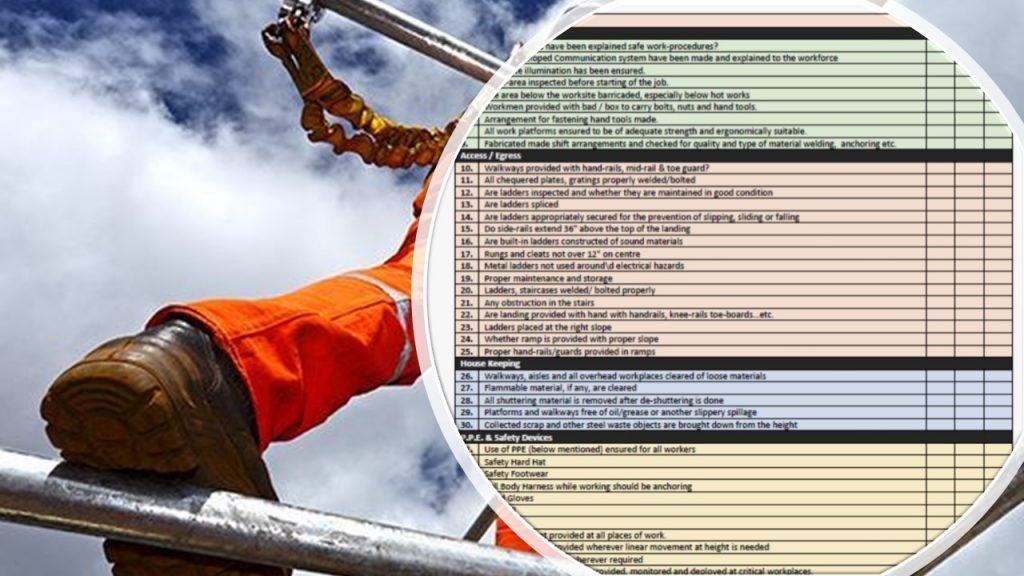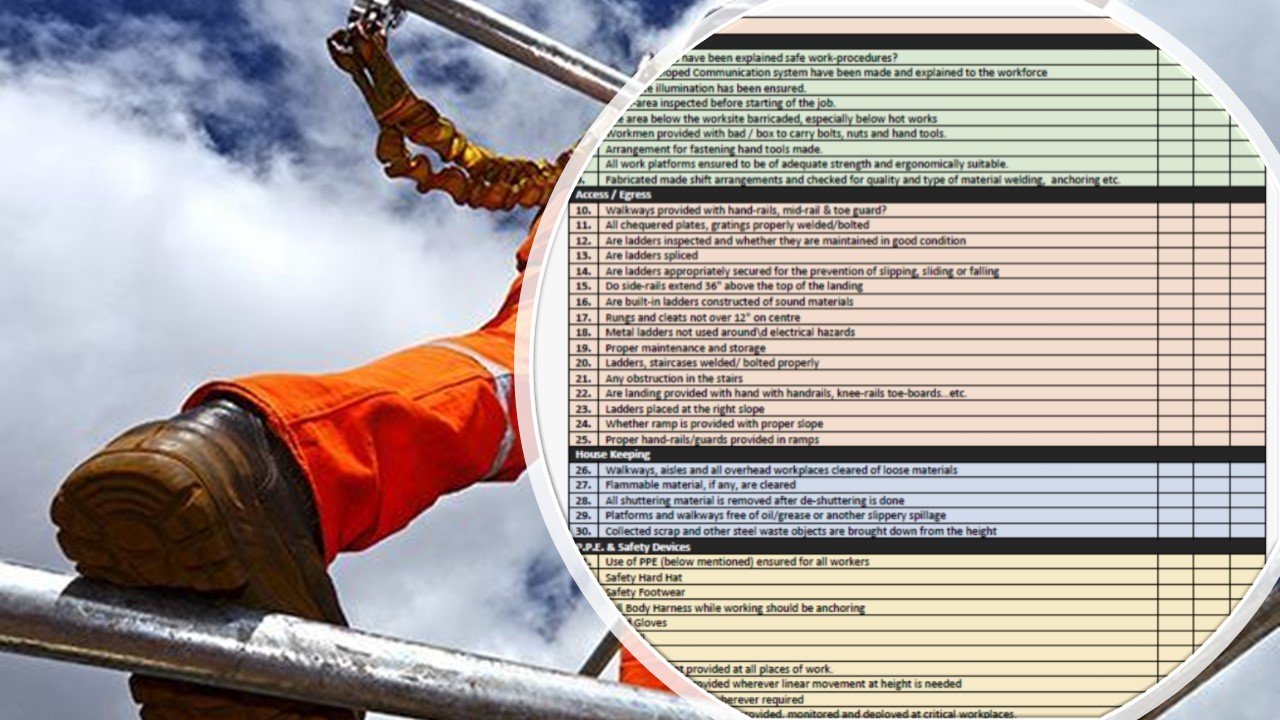Working at height remains one of the biggest causes of fatalities and major injuries. Common cases include falls from ladders and through fragile surfaces. ‘Work at height’ means work in any place where, if there were no precautions in place, a person could fall a distance liable to cause personal injury (for example a fall through a fragile roof).

What do I have to do?
You must make sure work is properly planned, supervised, and carried out by competent people with the skills, knowledge, and experience to do the job. You must use the right type of equipment for working at height.
Take a sensible approach when considering precautions. Low-risk, relatively straightforward tasks will require less effort when it comes to planning and there may be some low-risk situations where common sense tells you no particular precautions are necessary.
Control measures
First assess the risks. Factors to weigh up include the height of the task, the duration and frequency, and the condition of the surface being worked on.
Before working at height work through these simple steps:
- avoid work at height where it’s reasonably practicable to do so
- where work at height cannot be easily avoided, prevent falls using either an existing place of work that is already safe or the right type of equipment
- minimize the distance and consequences of a fall, by using the right type of equipment where the risk cannot be eliminated
For each step, always consider measures that protect everyone at risk (collective protection) before measures that only protect the individual (personal protection).
Collective protection is equipment that does not require the person working at height to act for it to be effective. Examples are permanent or temporary guardrails, scissor lifts, and tower scaffolds.
Personal protection is equipment that requires the individual to act for it to be effective. An example is putting on a safety harness correctly and connecting it, with an energy-absorbing lanyard, to a suitable anchor point
Dos and don’ts of working at height
Do….
- as much work as possible from the ground
- ensure workers can get safely to and from where they work at height
- ensure equipment is suitable, stable and strong enough for the job, maintained and checked regularly
- take precautions when working on or near fragile surfaces
- provide protection from falling objects
- consider emergency evacuation and rescue procedures
(Read More: how-to-inspect-your-fall-harness-when-working-alone/)
Don’t…
- overload ladders – consider the equipment or materials workers are carrying before working at height. Check the pictogram or label on the ladder for information
- overreach on ladders or stepladders
- rest a ladder against weak upper surfaces, eg glazing or plastic gutters
- use ladders or stepladders for strenuous or heavy tasks, only use them for light work of short duration (a maximum of 30 minutes at a time)
- let anyone who is not competent (who doesn’t have the skills, knowledge, and experience to do the job) work at height
working at Height checklist should be used to evaluate the working hazards and type of falling Protection the checklist below can help you and include the following Items:
Worksite Inspection
- All the workers have been explained safe work-procedures?
- A well-developed Communication system have been made and explained to the workforce
- Adequate illumination has been ensured.
- Work-area inspected before starting the job.
- The area below the worksite barricaded, especially below hot works
- Workmen provided with bad / box to carry bolts, nuts and hand tools.
- Arrangement for fastening hand tools made.
- All work platforms ensured to be of adequate strength and ergonomically suitable.
- Fabricated made shift arrangements and checked for quality and type of material welding, anchoring, etc.
Access / Egress
- Walkways provided with hand-rails, mid-rail & toe guard?
- All chequered plates, gratings properly welded/bolted
- Are ladders inspected and whether they are maintained in good condition
- Are ladders spliced
- Are ladders appropriately secured for the prevention of slipping, sliding or falling
- Do side-rails extend 36″ above the top of the landing
- Are built-in ladders constructed of sound materials
- Rungs and cleats not over 12″ on center
- Metal ladders not used around\d electrical hazards
- Proper maintenance and storage
- Ladders, staircases welded/ bolted properly
- Any obstruction in the stairs
- Are landing provided with hand with handrails, knee-rails toe-boards…etc.
- Ladders placed at the right slope
- Whether ramp is provided with proper slope
- Proper hand-rails/guards provided in ramps
House Keeping
- Walkways, aisles and all overhead workplaces cleared of loose materials
- Flammable material, if any, are cleared
- All shuttering material is removed after de-shuttering is done
- Platforms and walkways free of oil/grease or another slippery spillage
- Collected scrap and other steel waste objects are brought down from the height
P.P.E. & Safety Devices
- Use of PPE (below mentioned) ensured for all workers
- Safety Hard Hat
- Safety Footwear
- Full Body Harness while working should be anchoring
- Hand Gloves
- Coverall
- Goggles
- Anchoring Point provided at all places of work.
- General life-line provided wherever linear movement at height is needed
- Safety nets are in use wherever required
- A proper fall arrest system is provided, monitored, and deployed at critical workplaces.
- Crawler boards / Safety system for work on the fragile roof are used
(Read More:how-to-choose-your-fall-protection-anchorage/).
Download the Checklist
More Forms
- Camp Inspection form
- Machines Access Control Inspection Checklists
- Lift Plan Form
- Slips,Trips and Falls checklist
- Emergency Drill Table Top meeting Form
- Emergency Drill After Action Review form
- Compressed Gas Cylinders Access Control Inspection Checklist
- Competent Person Designation form
- Contractor Weekly HSE Report Form
- Safety Inspection Form
- Incident Report Form
- Job Hazard Analysis form
- OSHA Inspection Checklist 8-Pages
- Process Safety Management (PSM) Compliance checklist
- Portable Ladder Self Inspection checklist
- Scaffold Register and Inspection Checklist
- CRANE INSPECTION REPORT
- Laboratory Inspection Checklist Form
- Electric Arc Welding and Cutting Checklist
- Crane Suspended Personnel Platform (MANBASKET) Permit
- Pressure Testing Checklist
- Hygiene and Sanitation Inspection Checklist
- Permit to Work (PTW ) AUDIT CHECKLIST
- Equipment Safe Operating Procedures- SOP 61 checklist
- Construction safety Inspection checklist
- Fall safety at construction checklist
- Contractor Pre-qualification Questionnaire Checklist
- Lifeline & Harness Inspection Guide checklist
- Templates: Management of Change NEW Modified Equipment Safety Checklist
- Lock Removal Form
- Workplace Safety Inspections Forms
- Safety Templates: COVID-19 Safety Plan
- Construction Site Traffic Management Plan (CSTMP) Guidance
- Fire Pump Daily Inspection Checklist
- Health Safety at Work Improvement Action Plan
- Work at Height Checklist
- Canteen Inspection Checklist
- Electrical Isolation Permit to Work forms and checklist
- Job Safety Analysis (JSA) Forms What’s Right and Wrong?
- Lifting Plan Audit Checklist
- ISO 45001:2018 READINESS CHECKLIST
- Workplace Housekeeping Checklist
- Hazard Identification Checklist
- Free Pre-Startup Safety Review Checklist (PSSR)
- Ladder Inspection Form
- Hazard Identification Plan (HIP) Template
- HIRA, HSE Hazards & Effects Management Process (HEMP) & Risk Register Template
- Temporary Construction Facilities (TCF) Inspection checklist
- Simultaneous Operation (SIMOPS) checklist
- Mobile Scaffold Inspection checklist
- Annual Internal Audit Form
- General Safety Guidelines and Employee Acknowledgment form
- E-Books: Fire Safety Logbook templates
- Electrical Inspection Checklists
- Grating-Decking-Floor- handrail-Removal Form
- Photo of the day: New worker Orientation & Safety Orientation checklist
- Suspended Scaffold Pre-Operation Inspection Checklist




